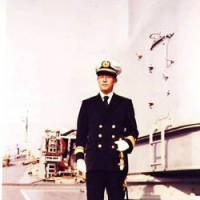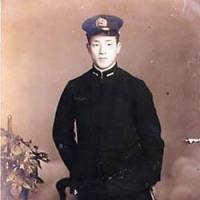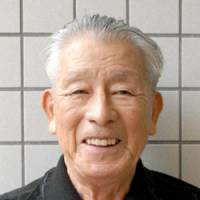As the public still debates the Imperial navy's activities during the war, many veteran sailors say that at the time, at least, they saw their objective as liberating Asia from Western colonial rule.
That is how Masayoshi Ito recalls the war.
"I remember visiting Singapore often during my missions. We had a good time on land, and we were never treated as aggressors," Ito, a long-serving officer, said.
Looking back, some of Japan's proudest war veterans believe their country went too far during the 1930s and '40s in asserting itself as a new power on the international stage.
But during that era, judging the right path of action from wrong amid the geopolitical turmoil was surely no easy task — one complicated by a sense that Western powers were encroaching on Asia and snubbing Japan as they did so.
Many Japanese were angered by the Washington Naval Limitation Treaty of 1922, which while granting Japan greater status as a world power also limited the navy to 60 percent of its U.S. and British counterparts — a concession widely derided at home as unfair. The 1930 London Naval Conference, putting similar restraints on Japan, was seen in a similar light.
Increasingly, the Japanese public felt Western powers must be routed from Asia, and that it was Japan's job to do it. "At least that is what we believed at the time," said Ito, a spry 84.
Born in Hiroshima Prefecture in August 1923, Ito enrolled at the elite Imperial Japanese Naval Academy, where more than 600 students were selected from around the country to be groomed for leadership roles in the navy. Among the school's best-known graduates was Fleet Adm. Isoroku Yamamoto, architect of the 1941 attack on Pearl Harbor.
Days spent at the school "weren't enjoyable," especially during the first year. Regulations were strict and upperclassmen often bullied new arrivals. Rumor had it that one classmate had been punched more than a thousand times during his first year at the academy.
The curriculum was equally demanding, with requirements that students study English, mathematics and military science, as well as receive practical training in mechanics.
"There wasn't much in the way of ideological lectures regarding the war," Ito said.
But that wasn't for lack of military zeal: Every classmate and teacher had no doubt Japan would win the war.
After his graduation in September 1943, Ito was assigned to the battleship Yamashiro, and later the aircraft carrier Junyo, cruiser Haguro and destroyer Kaede.
But after June 1942, when U.S. aircraft sank four Japanese carriers in the Battle of Midway, the war went downhill for Japan.
Perhaps because he is a military man to the core, or maybe because he has learned that composure is the best way to manage memories of war, Ito barely bats an eye when recounting the life of a sailor at battle stations.
On one hand, shipboard life included such mundane chores as swabbing the deck and painting walls.
But his expression barely changes when recalling how he and fellow sailors were also told to deal with the remains of comrades torn apart by Allied torpedoes. Taking them by small boats to islands, the sailors soaked them in oil and cremated them.
Ito had his own brushes with death. While aboard the Haguro near the Philippines, he witnessed the sinking of the aircraft carrier Taiho, a state-of-the-art vessel boasting the latest defenses.
He remembers the carrier "exploding abruptly, with a dizzying sound," after it was torpedoed by U.S. submarines at around 2:30 p.m. on June 19, 1944.
The attack left many crewmen abandoned at sea, and Ito himself was thrown overboard during a rescue mission. He grabbed a rope and returned to the Haguro but later learned his ship had almost fled the area to avoid being torpedoed as well.
"I came very close to being left floating on the Pacific that day," Ito recalled — surprisingly, with a chuckle.
By the time of Japan's surrender, Ito had traveled the corners of Japanese-occupied territory, including the Truk Islands, Singapore, Saipan, the Philippines, Taiwan and French Indochina (Vietnam).
On occasion, he would come across his father and older brother, fellow graduates of the academy. His father commanded an oil tanker and his brother was on a destroyer. The three eventually reunited in Japan, "extremely lucky," as Ito put it, to have survived.
Ito won't take credit for his rapid promotion to lieutenant, which took eight months instead of the usual five years.
"I made lieutenant only because others were dying in battle. There weren't many of us left, so we were being promoted quickly," he explained.
Right after the war, Ito sailed to Shanghai, the former Soviet Union, Okinawa and other locations to bring abandoned service members home.
After a brief stint selling soft drinks for a business run by relatives, in 1955 he returned to the sea — this time for the Maritime Self-Defense Force. He would eventually make rear admiral, the second-highest rank in the force.
Since retirement, Ito has spent his time golfing and keeping in touch with friends, recently through e-mail and blogs. Undaunted by information technology, he launched a Web site dedicated to the academy's Class of 1943 at www5f.biglobe.ne.jp/~ma480/
With vivid wartime accounts posted by classmates, visitors and Ito himself, the site has built a devoted readership in the less than three years since its debut. "Creating a home page is nothing complicated," he said.
Inevitably, perhaps, controversial opinions find their way to the site, including some that rationalize the war. Ito leaves them unedited, allowing visitors to express their opinions freely.
"I welcome all opinions. People can meet and speak freely," the Web master said.
Ito prefers not to discuss his views on "comfort women" or the Nanjing Massacre of 1937, which some posts on his Web site claim to be fictitious.
But he will offer that the Imperial army "may have mistreated" many of its Asian neighbors in fighting the war.
Nonetheless, he bluntly defends his annual visits to Yasukuni Shrine, where fallen comrades, including 335 of his 625 fellow members of the Class of 1943, are honored for dying for the Emperor. Critics slam Yasukuni for enshrining 14 Class-A war criminals.
As unfathomable as Yasukuni may be to those who didn't serve in the Japanese military, for Ito it holds special significance as the resting place for many of his comrades' souls.
"We'd often promise each other to reunite at Yasukuni Shrine before heading out on a mission during the war. 'I'll see you at Yasukuni' is what we used to say," Ito said.
Pilgrimages to the Shinto shrine will likely continue.
"It could be difficult for other people to understand this — but the shrine holds a very significant importance for me."
In this series, The Japan Times interview firsthand witnesses of Japan's march to war and ensuing defeat who wish to pass on their experiences to younger generations. This is the eighth installment of the Witness to War series. To read more, see the Witness to War archive.



















With your current subscription plan you can comment on stories. However, before writing your first comment, please create a display name in the Profile section of your subscriber account page.